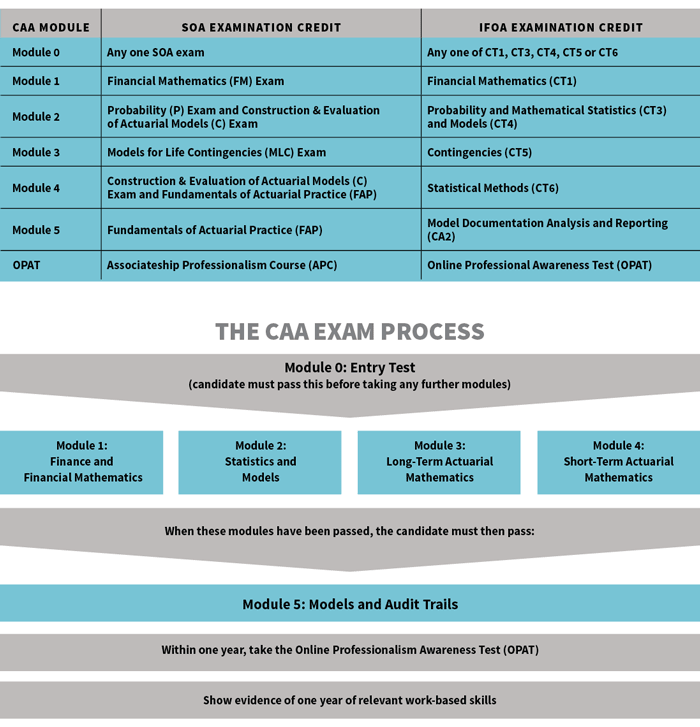A New and Different Pathway
Exploring the certified actuarial analyst (CAA) qualification June/July 2017The certified actuarial analyst (CAA) qualification is offered by a recently formed joint venture entity, CAA Global. The Institute and Faculty of Actuaries (IFoA) and the Society of Actuaries (SOA) joined forces to form CAA Global to offer this international qualification to individuals who have excellent technical and analytical expertise that they can leverage in analyst roles in the insurance and financial services industries.
The qualification equips individuals with financial, business, analytical and modeling skills, allowing candidates to differentiate themselves in the market while allowing employers to identify candidates who are best suited for these roles. The CAA qualification will help assure employers and the public of the quality of the work performed in support of insurance and financial services products.
Ongoing Affiliation for Qualified Individuals
With the addition of this qualification, there is now an opportunity for individuals to receive important training and ongoing professional development, and network with other CAAs. Once they complete the pathway, CAAs can choose among accredited organizations with which to affiliate—those that are accredited by CAA Global. The first accredited organizations are the IFoA and the newly created SOA subsidiary, the SOA Center for Certified Actuarial Analysts. These organizations will offer the professionalism structure that maintains the value of the qualification for CAAs by holding affiliates up to high standards of conduct and practice. They also will provide access to networking, events, resources, continuing educational opportunities and more. In time, other actuarial associations will be able to apply to CAA Global to become accredited organizations to accept CAAs as members. CAAs can then choose those affiliations as well.
The CAA Pathway
The CAA pathway to qualification has seven components. With the exception of Module 0, they should look familiar to actuaries, as the learning objectives span the breadth of subjects that actuarial practice comprises. Module 0 is a unique feature that allows candidates to verify at the outset if they have the ability to complete the subsequent requirements. It covers basic mathematics and statistics, with no reference to actuarial practice. It must be passed prior to attempting later modules.
The five modules that follow cover the fundamental areas in which actuaries work, but at an introductory level relative to the exams required for the ASA designation. Following is a description of the modules and how they relate to the corresponding parts of the ASA pathway. The exam questions focus more on recollection and basic calculations rather than solving complex problems.
Module 1: Finance and Financial Mathematics
The time value of money, annuities, bonds and loans is covered. While the topics are similar to the SOA’s Exam FM, only the most basic versions are included. For example, there is no coverage of increasing or decreasing payments, or of duration, convexity and immunization.
Module 2: Statistics and Models
While many of the same statistical methods are covered as in current Exam P and will be covered in the Mathematical Statistics VEE requirement beginning in 2018, there is less theory.
Module 3: Long-Term Actuarial Mathematics
This module covers life contingencies, including the basics of pricing and reserving for life insurance, annuities and retirement benefits.
Module 4: Short-Term Actuarial Mathematics
This module includes the basics for nonlife insurance products, such as health, property and liability.
Model 5: Models and Audit Trails
This module covers good practice in building and documenting models, particularly in a spreadsheet environment. The ASA pathway covers these topics in the Fundamentals of Actuarial Practice modules.
Online Professional Awareness Test (OPAT)
This component ensures that those who hold the CAA credential understand the professional requirements. As with the Associateship Professionalism Course, there is a Code of Conduct component to this test, and for OPAT, it is the CAA Global Code of Conduct. However, rather than using an in-person seminar, the CAA pathway does this through an online tutorial and assessment.
The CAA Difference
It is important to emphasize that the pathway for the CAA is entirely separate from the pathway to become a credentialed actuary. When comparing the CAA pathway to the incoming ASA requirements (effective 2018), there are some key elements of the ASA qualification that are not included. They are accounting, corporate finance, investments, predictive analytics, standards of practice and further exposure to more complex actuarial problems through case studies.
Given the separate pathway, requirements and expectations, it should be understood that individuals earning the CAA qualification are not expected to function at the same level as fully qualified actuaries. They are analysts expected to function in actuarial support roles. In fact, CAAs who wish to pursue an associateship must separately fulfill all requirements of an ASA.
CAAs who choose to affiliate with the SOA Center do not become members of the SOA. The SOA Center has a separate code of conduct appropriate for analysts and their professional roles.
Find Out More
For more information, visit caa-global.org. You can send email inquiries to enquiries@caa-global.org, or call one of the following numbers:
- U.K.: 44 (0) 1865 268 266
- U.S.: 1-844-839-1679 (toll-free)
- U.S.: 1-847-273-8890
Enhancing Support for Actuaries
“We are hopeful that SOA members will see the significant benefits of the qualification and encourage their employees working with actuaries in support roles to pursue the CAA qualification,” says SOA President Jerry Brown, FSA, MAAA.
Working with our partner, the IFoA, the SOA’s involvement in CAA Global and offering the CAA helps fulfill our common objectives to advance—in the public interest—all matters relevant to actuarial science and to promote the actuarial profession.
Exam Exemptions
If you have previously taken and passed Institute and Faculty of Actuaries (IFoA) or Society of Actuaries (SOA) exams, you may qualify for exemptions on the CAA pathway. Individuals with SOA and IFoA exam credits will be exempt from the CAA modules listed below, provided the credits were earned by June 30, 2018.


